The MSI GT80 Titan Review: The Broadwell Gaming Laptop Your Desktop Envies
by Brett Howse on June 26, 2015 8:00 AM ESTSystem Performance
Intel’s Broadwell rollout has been fairly drawn out, with the first chip made on the 14nm process being Core M way back in October 2014. At CES, Intel launched the Broadwell-U processors which were 15-28 watt TDPs, but all dual-core. With Intel trying to make a bigger push into mobile, even the Atom processor got moved to 14nm before the quad-core Core parts, but finally as of June 2nd, Intel launched some quad-core laptop parts and a couple of desktop parts.
MSI sent along the latest update to the GT80 Titan which is powered by the Intel Core i7-5700HQ processor. As with any CPU update, Intel has made a few tweaks to the architecture which will gain a few percentage points in IPC, however this is in essence a die shrink on Haswell, so we have to keep expectations in check. What we have seen on the Broadwell-U line is better battery life, and a nice boost in performance by the processor being able to maintain higher turbo frequencies while keeping within its thermal envelope.
With a TDP of 47 watts, the i7-5700HQ, it will be interesting to compare how the Broadwell quad-core parts compare to Haswell. The i7-5700HQ has a base frequency of 2.7 GHz and a turbo of 3.5 GHz. There is not a perfectly comparable Haswell part that we have tested however the i7-4720HQ has been in several devices this year and has a slightly lower base of 2.6 GHz and a slightly higher turbo of 3.6 GHz which should make an interesting comparison.
I have put the GT80 Titan through our standard laptop workload, and picked some comparative devices. Take note that the Clevo P750ZM actually has an 88 watt desktop CPU inside. The MSI GT72 Dominator Pro has a 47 watt TDP and the same 3.5 GHz turbo frequency so it should be a great comparison for Haswell versus Broadwell. If you want to compare the GT80 Titan to any other laptop we have tested, please use our Notebook Bench.
PCMark
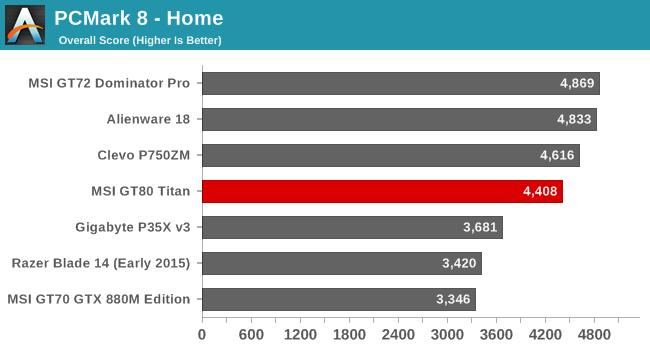
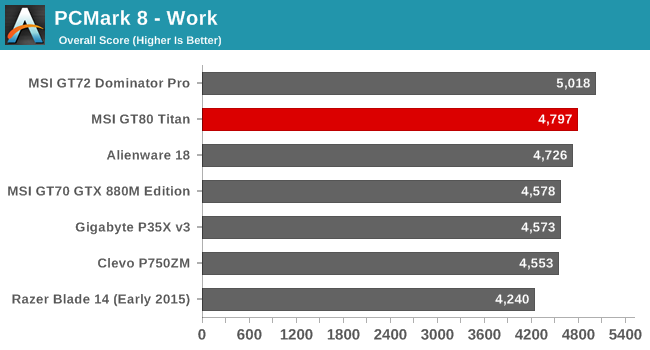
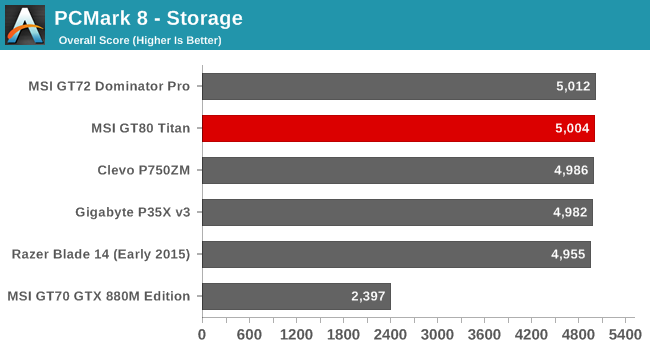
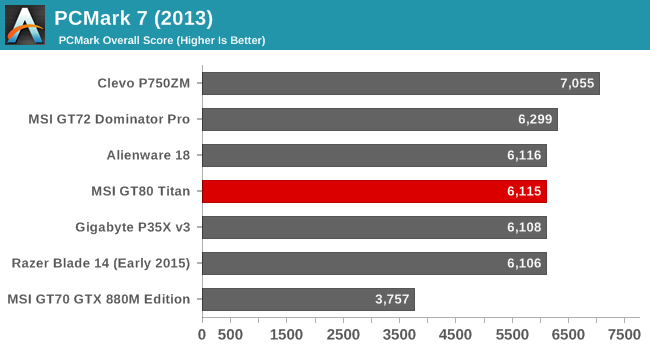
PCMark tries to simulate some real life workloads, with several different subtests for different sets of tests. It is not a pure CPU test, and also factors in memory, storage, and even display resolution. The GT80 does not outright win these tests however it is competitive. The two SSDs in RAID 0 help boost it to one of the higher storage scores, and for the target market the extra cost and loss of battery life of RAID 0 is fine. One thing to note is that the Creative test on PCMark 8 would fail to run on this device, so there was no score recorded for that test.
Cinebench
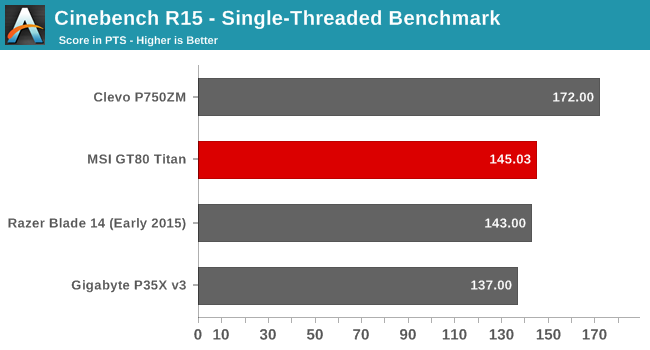
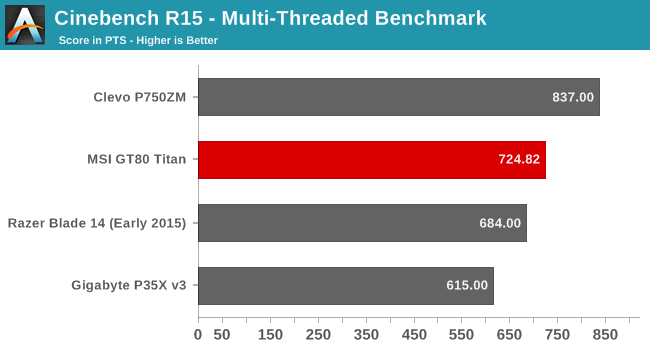
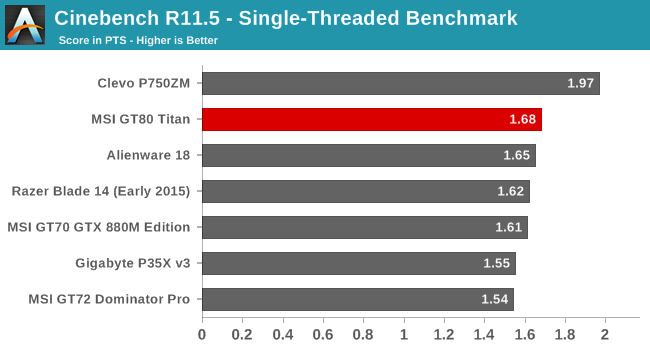
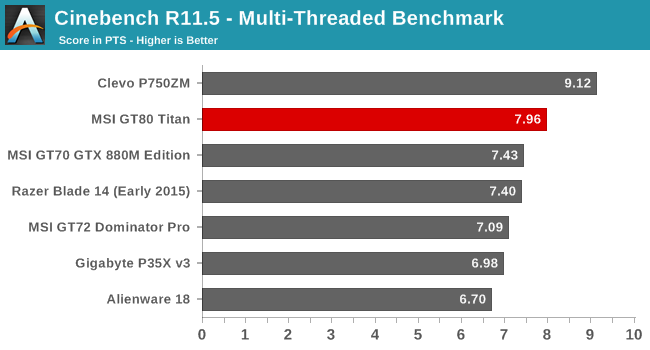
Cinebench is more of a pure CPU test, and it favors high frequencies and IPC. Here we get a better feel for Broadwell and the i7-5700HQ performs very well. It outperforms all of the other 47 watt processors we have tested despite not having the highest turbo frequency.
x264
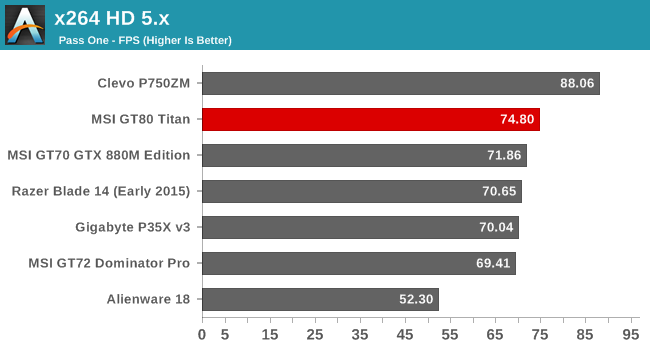
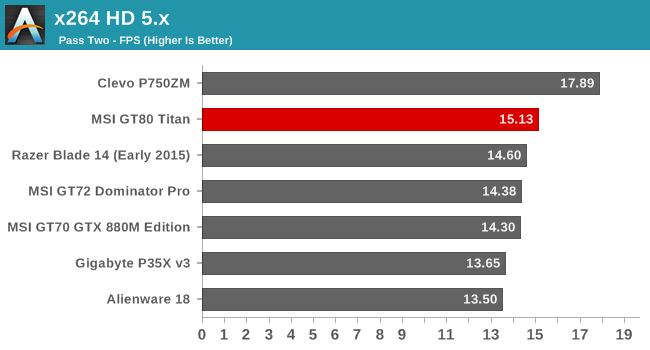
Once again, the i7-5700HQ outperforms all other 47 watt parts although it can’t compete with the 88 watt P750ZM. The move to 14nm clearly opens up some additional headroom to keep the turbo frequencies up.
Web Tests
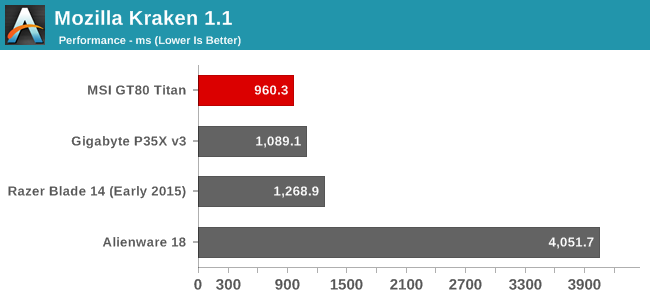

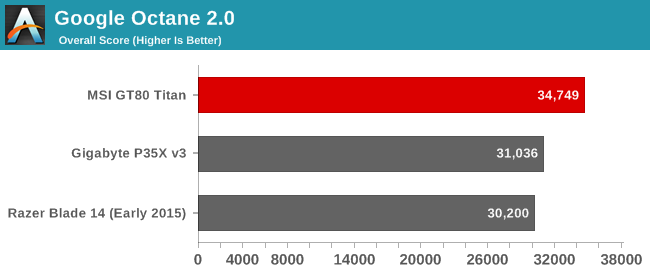
Our web tests continue the trend that has already been set. Once again the GT80 Titan sets the standard, and is only trumped by a notebook with a desktop processor.
Broadwell may just be a die shrink of Haswell, but the 14nm process is very effective. Despite having a maximum frequency of just 3.5 GHz, the i7-5700HQ outperforms Haswell parts that can turbo up a few hundred megahertz more, which is pretty impressive.










103 Comments
View All Comments
mr_tawan - Friday, June 26, 2015 - link
Actually I like the fact that the touchpad is on the right side, and wonder why no manufacturer does this for a second. I realized afterward that this layout does not work (at all) for those left-handed.Still, just like the article suggested, the user would go with a mouse anyway.
andrewd18 - Friday, June 26, 2015 - link
Many of us left-handed users have become accustomed to mousing with the right hand. I, for one, wouldn't mind the trackpad being on the right.Refuge - Friday, June 26, 2015 - link
I'm glad you have been able to adapt so well.I'm right hand dominant, but I'm also ambidextrious because I cut my fingers off when I was younger, so I had to adapt.
But I feel bad for all the dominant lefty users out there, you guys always get the short end of the stick on quite the regular when it comes to the gaming market.
DanNeely - Friday, June 26, 2015 - link
Razer Has been selling a few lefthanded mice for years. So much better than the ambidexterous mice I had to use before.Ktracho - Friday, June 26, 2015 - link
I would think having the trackpad on the right could be a benefit for left-handed users, since they could then have a mouse on the left side, and not have to move their hand so far. I dislike having a keypad on the right, and then having to put the mouse even further to the right. I used to have an IBM keyboard that allowed one to put the keypad on either side of the keyboard, so I would put it on the left. As someone who plays piano, I can type numbers well enough with my left hand. My current keyboard does not have a keypad at all.Gonemad - Tuesday, July 7, 2015 - link
I bought a logitech G5, and back then it was the first right-hand oriented mouse I ever bought. However, I had no issues with it, even being left handed. Turns out it is even better, because I use it at an angle that matches the space on the desk, and all those buttons for DPI changing end right below the other 4 fingers, not the thumb, which allows some stunts right handed folks can't pull. I end up using the middle finger very often on the main button, leaving one finger for right-clicking, adding insult to injury, so to speak.I still have that mouse.
Ian Cutress - Saturday, June 27, 2015 - link
I think I read at one point the CEO of Razer said that only 10% of left handers actually use the mouse in the left hand, and given that 10% of people are left handed that accounts for 1% of users. Depending on which market you're talking about, that's either good or bad. I think he also said that because of the design differences, they never sell enough left handed mice to make a proper profit and are glad if they break even on those designs.Zak - Friday, June 26, 2015 - link
Expensive. Powerful. No G-SYNC support? At that price point there is no excuse not to have G-SYNC. There is no excuse not to have G-SYNC or Freesync support in anything you put a "gaming" label on these days.Refuge - Friday, June 26, 2015 - link
At that price, there is no point for it not to come with a Blowjob too if you ask me.MVM upgrades aren't an answer to laptop longevity if you ask me. They are so absurdly expensive to source, I would much rather just but a new laptop and sell my old one.
sabrewings - Friday, June 26, 2015 - link
Very interesting bit of kit from an engineering standpoint. However, in the looks department it looks like a 90s laptop:https://cdn2.content.compendiumblog.com/uploads/us...
Not sure I would want to be seen with such a thing. And no, it doesn't make my desktop jealous. ;-)